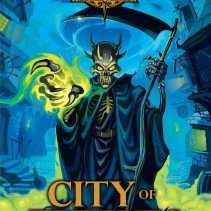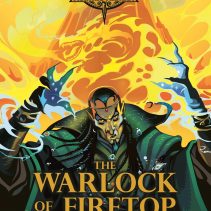Unknown to most residents of Chiang Mai, the 1981 backpacking adventures of an unassuming young Englishman hailing from Prestbury, Cheshire would go on to immortalise our fair province as part of a worldwide publishing phenomenon and international ‘playground craze’ of the early-to-mid-1980s. The phenomenon was the Fighting Fantasy series of adventure gamebooks which — spearheaded by best-selling titles like The Warlock of Firetop Mountain, Deathtrap Dungeon, Forest of Doom, and City of Thieves — would go on to sell more than 20 million copies and be translated into 32 languages.

Traipsing about northern Thailand with camera, notebook and an imagination fuelled by years of playing the American role-playing game Dungeons & Dragons, Fighting Fantasy co-creator Ian Livingstone was profoundly influenced by the people and places encountered while trekking — so much so that he began formulating ways to position towns, rivers and other geographical features of Chiang Mai in the main Fighting Fantasy world of Allansia. In Livingstone’s phenomenally popular gamebook Deathtrap Dungeon (which has spawned numerous video game interpretations and twice been optioned for film adaptation) the adventure takes place in the fanciful town of Fang, capital of the fantasy province of Chiang Mai, situated along the fictional River Kok.
Uniquely combining elements of non-linear or branching path narrative with aspects of role-playing games, a gamebook is a work of participatory fiction in which the story (or, in the case of Fighting Fantasy, the adventure!) branches along various paths determined by the reader (usually referred to in Fighting Fantasy as ‘the adventurer’). Informed by rules governing game-play, the reader guides the story between numbered sections of text, navigating terrain, solving puzzles, collecting treasure and magical items, and battling monsters (usually via a straightforward dice-based combat system) while working towards completing the goal of the adventure detailed at the beginning of the book.
Noticing a resurgence in the genre coincident with the thirty-fifth anniversary of Fighting Fantasy’s heroic adventures, Scholastic recently acquired the classic gamebook series not simply to republish old best-sellers — instead, selected gamebooks from the original series have been “repackaged and reignited for a new generation.”
According to Livingstone, “People were noticing [that] many of those who read Fighting Fantasy in the 1980s now had their own children, and were passing on their Fighting Fantasy books to them. Normally children reject out-of-hand anything that their parents say is cool or fun, but Fighting Fantasy seems to have struck a chord with a new generation. They enjoy being in control of the story in the same way their parents did back in the 1980s.”
Scholastic’s re-launch of Fighting Fantasy includes five classic titles plus Ian Livingstone’s new gamebook, The Port of Peril. A second tranche of gamebooks will be published in April 2018.
Players: 1
Playing time: 60-90 minutes
Age: 8+
Authors: Ian Livingstone and Steve Jackson
Publisher: Scholastic



